Mad Hedge Biotech and Healthcare Letter
March 27, 2025
Fiat Lux
Featured Trade:
(NO SHERPA REQUIRED)
(MRK), (BMY)

Mad Hedge Biotech and Healthcare Letter
March 27, 2025
Fiat Lux
Featured Trade:
(NO SHERPA REQUIRED)
(MRK), (BMY)

Perched high above the timberline on Colorado's Mt. Elbert last weekend, I found myself short on oxygen and long on questions—namely, which pharmaceutical heavyweight deserves a spot in my portfolio: Merck (MRK) or Bristol-Myers Squibb (BMY)?
At 14,438 feet, the air thins out fast, but the thinking gets clearer. Clarity tends to arrive when your brain’s running at 60% capacity.
I’d stuffed my pack with company reports, earnings transcripts, and a few too many granola bars—one of which was being stalked by a very persistent marmot as I paused to catch my breath. I must’ve looked like an underprepared Everest hopeful, hunched over charts and trying to find altitude-adjusted alpha.
On paper, both firms dominate the oncology space and have made a career out of telling cancer where to shove it. But markets don’t care about reputations—they care about margins, pipelines, and who's going to make it through the next patent cliff without blowing out their kneecaps.
Let’s start with the money.
Merck posted Q4 2024 revenue of $17.76 billion, up 6.77% year-on-year. Its price-to-sales ratio sits at 3.74x—above the sector median, but still 14.7% cheaper than its own five-year average. It’s also beaten revenue expectations for 12 straight quarters. That’s not a hot streak. That’s clinical precision.
Bristol-Myers pulled in $12.34 billion last quarter with 7.5% YoY growth, but it trades at a much lower 2.51x P/S. That’s a discount—16.5% under the sector median. Ten out of twelve quarters beating the Street is nothing to sneeze at either. You get the sense both firms have their accounting departments on creatine.
Debt? Merck sits on $24.6 billion in net debt, but with a net debt/EBITDA ratio of 0.84x, it's practically sipping debt through a paper straw. Bristol-Myers, on the other hand, carries $40.1 billion with a 2.07x ratio. Still manageable, but not the kind of leverage that makes you sleep like a baby—unless you're the baby in question.
Dividends? Bristol-Myers pays more—4.14% vs. Merck’s 3.42%. That might earn it a second glance from income hawks, but when you zoom out, Merck still wears the financial crown.
Now here’s where things get messier.
Merck has a bit of a single-product addiction problem. Keytruda brought in $7.83 billion last quarter, making up a jaw-dropping 50.2% of total revenue. It's a blockbuster, yes, but when one drug makes up half your business, you start looking like a biotech version of Jenga. Merck’s top five products represent 75.7% of sales.
Bristol-Myers shows better balance. Eliquis is its biggest hitter, pulling in 25.9%, while its top five products account for 71.6% overall. Not exactly ironclad diversification, but a more even spread than Merck’s lineup.
Still, Keytruda is a monster. It outsold Bristol’s Opdivo by a whopping $5.4 billion in Q4 alone. That’s not a competition—that’s a beatdown. But both companies are running out the clock on their oncology flagships. Keytruda loses U.S. patent protection in 2028. Merck’s answer is a subcutaneous version—MK-3475A—patent-protected until 2039. Bristol’s already fired back with Opdivo Qvantig, a smart preemptive strike that could buy them time and market share.
Pipelines? Merck leads here too. BMY has 74 active R&D projects, 11 in Phase 3. Merck? Over 90 clinical-stage assets, 31 of them in Phase 3, and five are already under regulatory review. They’re not just defending Keytruda—they’re building the next dynasty.
Meanwhile, Bristol-Myers’ stock is flashing overbought signals like a Christmas tree. Merck, by contrast, trades below its VWAP, and Wall Street sees an 18.3% upside from here. Bristol-Myers? A yawn-worthy 1.36%. That's a rounding error, not an investment thesis.
Fast forward to 2029. I expect Merck to print a non-GAAP EPS of $11, led by Keytruda, Welireg, and a few wild cards currently in late-stage trials. Bristol-Myers might reach $6.80 EPS on $44 billion in revenue. Not bad, just... not Merck.
After sorting through this on the summit—between water breaks, altitude headaches, and one increasingly assertive marmot—the picture came into focus. Merck is the better long-term pick. They’ve got the product, the pipeline, the margin, and the momentum.
As I packed up and started the long descent, I dropped my guard for half a second and the marmot made his move—snatched my energy bar right off my pack. Bold little bastard. But honestly, he earned it.
Sometimes, the one who climbs higher sees further and waits patiently gets the prize. Merck just did all three.
After all, in investing—as in mountain climbing—peaks and profits favour those who don’t lose their breath or their nerve.
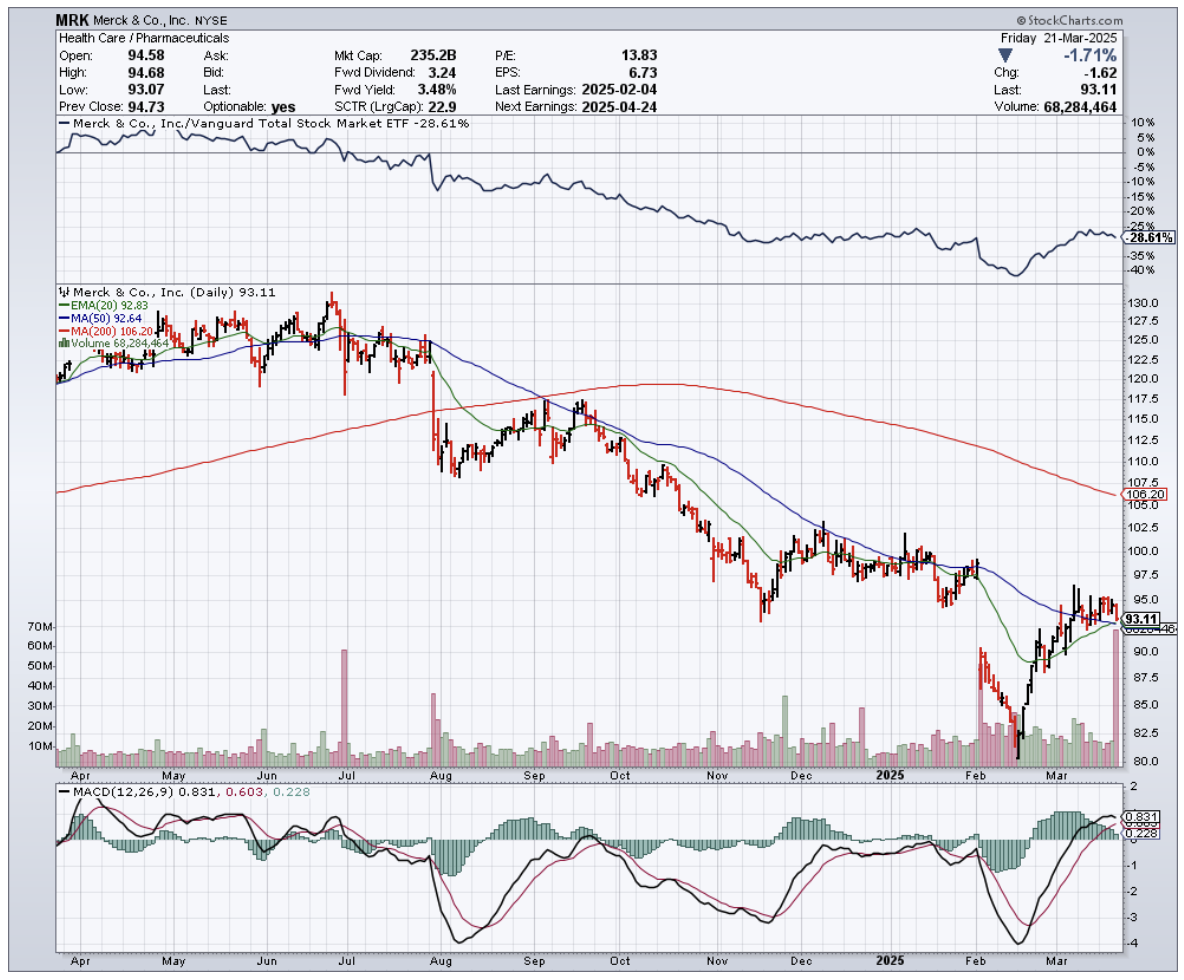
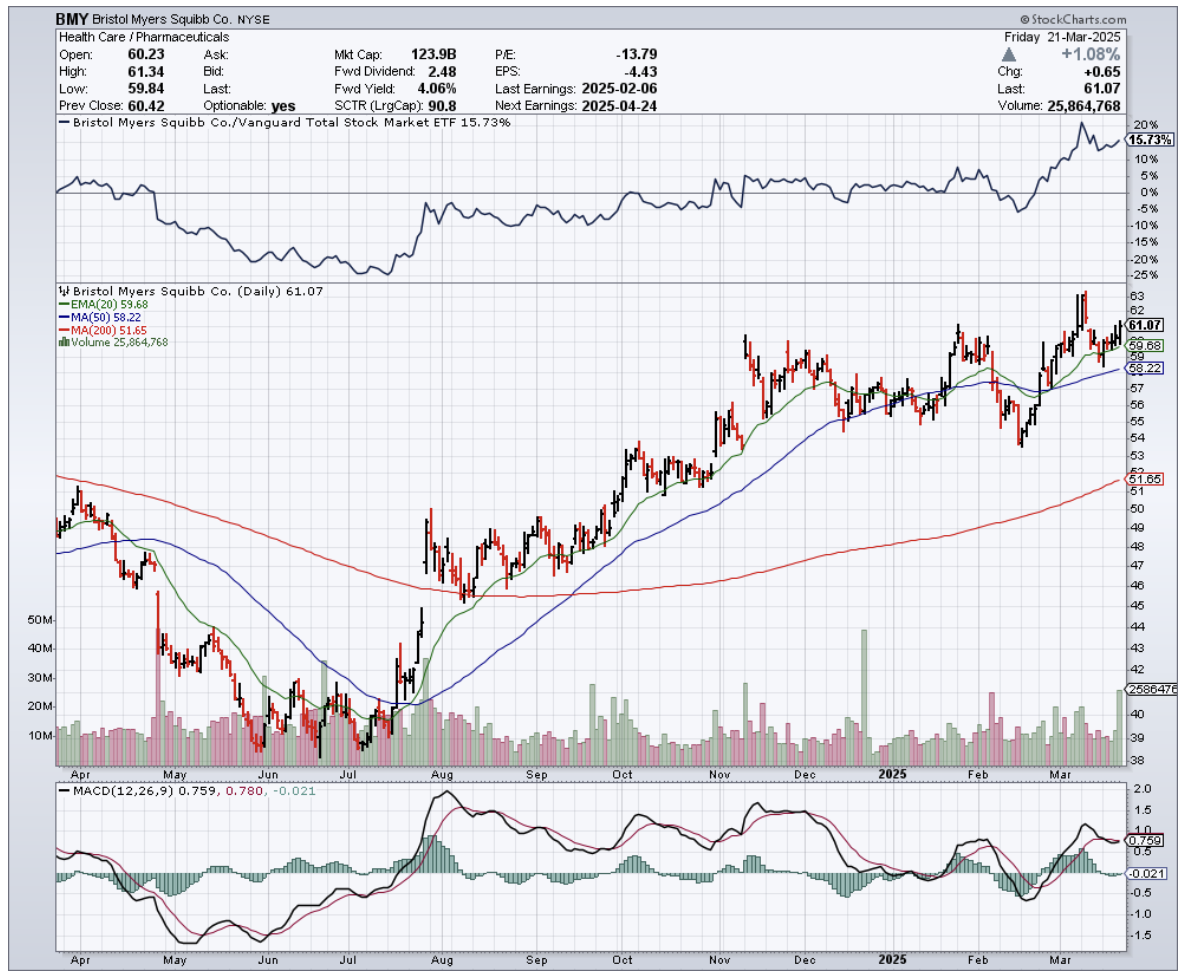
Mad Hedge Biotech and Healthcare Letter
March 20, 2025
Fiat Lux
Featured Trade:
(EVEN A PIG COULD MAKE MONEY HERE)
(OGN), (MRK), (RHHBY), (BAYRY), (PFE), (AZN)
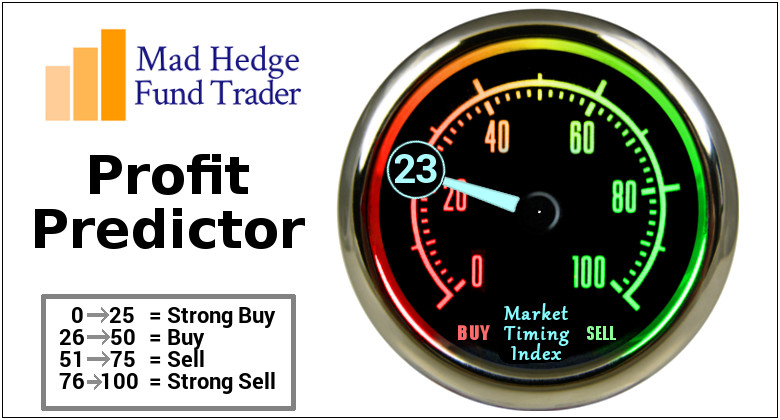
I was camped out in Kyiv the other month when news of Organon's (OGN) earnings hit my phone.
While Russian drones buzzed overhead, I was studying pharmaceutical balance sheets—talk about surreal. Did I mention I've led a strange life?
In mid-February, Organon pleasantly surprised me with Q4 2024 results. Hadlima, their biosimilar to Humira, rocketed to $44 million in quarterly sales, up 83.3% year-on-year.
Meanwhile, Organon's dividend yield sits at a whopping 7.32%, blowing away the healthcare sector average.
Let me be blunt: this is an income investor's dream hiding in plain sight.
Organon emerged in 2021 when Merck (MRK) spun off its women's health, biosimilars, and off-patent drugs businesses. This allowed Merck to focus on its immunology and oncology pipeline while Organon became a pure-play commercial entity.
These spinoffs often create enormous value that the market misses in the early years.
Organon's share price has been trading sideways since early 2025 despite several wins: commercializing Hadlima, acquiring Dermavant, and maintaining a 23% operating margin even as some medications face generic competition.
The market clearly isn't paying attention. When stocks with this kind of dividend yield maintain solid margins, my antennae start twitching.
Their recent Phase 3 ADORING 3 study showed that even 79.8 days after stopping Vtama treatment, atopic dermatitis remained mild. That's patient retention gold, folks.
When patients can stop medication and still see benefits almost three months later, that's the kind of sticky customer base pharmaceutical execs dream about.
Revenue hit $1.59 billion in Q4 2024, down just 0.63% year-over-year but up 0.63% quarter-over-quarter.
Renflexis sales reached $64 million, down 16.9% due to competition from other Remicade biosimilars and superior new medications like AbbVie's (ABBV) Skyrizi.
But here's where things get interesting—this sales decline was expected and already priced in. Organon isn't being valued in Renflexis's future.
The real stars? Nexplanon and Vtama. Nexplanon sales reached $258 million in Q4, up 11.7% year-on-year.
Even better, its patent protection runs until August 2030. CEO Kevin Ali expects it to "comfortably get beyond $1 billion in 2025."
When a CEO uses words like "comfortably" about billion-dollar projections, I tend to listen.
Vtama, acquired in the $1.2 billion Dermavant purchase, brought in $12 million in partial Q4 sales.
The FDA expanded its label in December 2024 to include atopic dermatitis in patients over age 2—a condition affecting 31.6 million Americans. This approval significantly expands its market potential.
Remember, blockbuster drugs don't announce themselves with trumpets—they sneak up on you through expanded indications and growing prescriber bases.
Now, many folks will point to Organon's debt—$8.36 billion at 2024's end. But that's lazy analysis.
Look deeper and you'll see its net debt/EBITDA ratio improved from 5.01x to 4.74x over 12 months. They're steadily strengthening their financial position.
I've watched this happen before with pharma spin-offs—initial debt concerns gradually fade as strong cash flows tackle the balance sheet.
Management knows what they're doing. For 2025, they forecast a slight revenue dip but improved EBITDA margins of 31-32%, outperforming competitors like Perrigo, Alvotech, and Amneal.
In the broader pharmaceutical landscape, Organon competes with heavyweights like Roche (RHHBY), Ferring Pharmaceuticals, Bayer (BAYRY), Pfizer (PFE), and AstraZeneca (AZN)—but with a more specialized focus that gives them maneuverability these giants lack.
Wall Street's average price target is $20.50, suggesting a 33.9% upside. When was the last time you saw a 7.32% dividend yield with 33.9% upside potential?
I project non-GAAP EPS to reach $4.52 by 2029, slightly above analyst estimates, driven by Hadlima, Nexplanon, and Vtama growth, plus upcoming biosimilars HLX14 and HLX11. My friends at major healthcare funds are starting to take notice, but the broader market hasn't caught on yet.
At $15.31 per share, Organon trades at a non-GAAP P/E of 3.39x—80.8% below the sector median and 25.7% below its 5-year average. That's not just cheap—that's backing up the truck cheap.
You know what they say about bears and bulls making money, while pigs get slaughtered? Well, at these valuations, even a pig could make money on Organon.
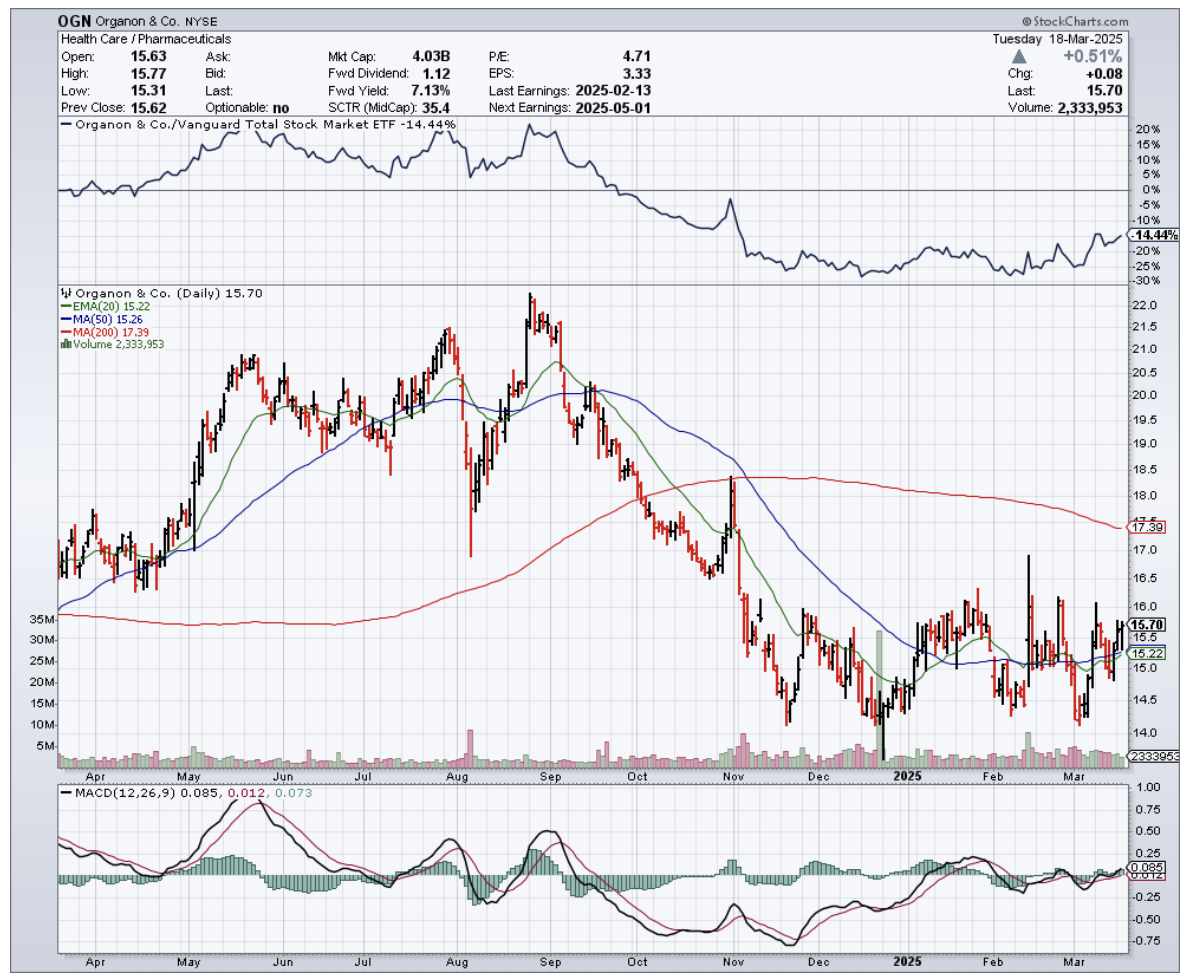
Mad Hedge Biotech and Healthcare Letter
March 11, 2025
Fiat Lux
Featured Trade:
(WHEN INSIDERS GO SHOPPING, PAY ATTENTION)
(MRNA), (MRK)

In 1815, Nathan Rothschild made his legendary fortune buying British securities when they were deeply discounted after Waterloo. “Buy when there's blood in the streets,” he allegedly said. That kind of contrarian wisdom has made fortunes across centuries.
Two centuries later, I find myself applying this timeless principle to Moderna (MRNA). The biotech darling has shed over 90% of its value since the pandemic peak, plummeting from $400+ to under $30. And now, insiders are quietly loading up.
The shift in insider activity at Moderna has been striking. Over the past year, insiders unloaded more than 602,000 shares, with the heaviest selling in 2024 when the stock was trading above $120.
One director alone offloaded 202,832 shares in a single transaction, pocketing $30 million. But as Moderna’s share price took a nosedive, insider selling slowed to a trickle. By the time the stock fell below $100, most trades involved fewer than 1,000 shares.
Then, on March 3, the narrative took a dramatic turn: two insiders — including CEO Stéphane Bancel — scooped up nearly 200,000 shares, investing about $6 million. Bancel accounted for $5 million of that sum.
This move is telling. Bancel already controls over 21 million shares. You don’t drop another $5 million into a stock unless you believe you're buying Manhattan for beads and trinkets. The contrast is stark: when prices were high, executives couldn’t sell fast enough. Now, they’re buying.
The timing of these insider purchases is even more intriguing. Moderna had just slashed its 2025 revenue target by $1 billion, bringing guidance down to $2.5 to $3.5 billion. Yet, insiders chose that precise moment to buy, signaling confidence that sales will bottom out this year.
The company's drug pipeline isn't barren, either. Ten drugs are expected to receive FDA approvals by 2027, including a skin cancer vaccine developed with Merck (MRK) slated for a 2027 launch, pending Phase 3 data.
These ten anticipated drugs collectively target a market exceeding $30 billion, with analysts projecting Moderna's revenue to climb to $3.3 billion in 2027 and $4.77 billion by 2028.
On their Q4 '24 earnings call, President Stephen Hoge underscored the cancer vaccine’s potential: "As for INT, obviously, we're all looking forward to the melanoma -- adjuvant melanoma Phase 3 readout. As you know, and as I mentioned, there are additional Phase 3s as well as two randomized Phase 2s, including bladder cancer, renal cell carcinoma, which, depending on the rate of approval of events, could have readouts that we would be updating on as well in the coming years."
Still, the road ahead isn’t without challenges. Moderna expects to burn up to $3.5 billion in cash during 2025, reducing its cash position to $6 billion. Estimated cash costs for 2025 stand at $5.5 billion, projected to decline to $5 billion in 2026.
To reach breakeven by 2028, the company needs to generate $6+ billion in sales at 80% gross margins or implement further cost-cutting measures.
Despite these financial hurdles, Moderna's market cap is a mere $14 billion — practically pocket change for a company with multiple promising vaccine candidates.
There's undeniable risk in buying Moderna at these levels, but historically, the most profitable investments come before the financials improve. The company has effectively announced that its numbers will likely deteriorate further before rebounding — and yet, insiders are still buying.
Speaking of gathering valuable insights from industry leaders, I’ve been preparing for our Mad Hedge Traders & Investors Summit on March 11-13.
After decades in the markets, I’ve learned there’s something uniquely valuable about getting multiple perspectives in one place. It reminds me of my time in Tokyo during the '70s, where real opportunities often emerged from late-night conversations between veteran traders.
Even in today’s volatile environment, the wisdom of those who’ve navigated every market cycle remains invaluable.
In the end, Moderna presents a textbook contrarian opportunity. The stock is deeply out of favor, yet insider buying suggests a potential shift in sentiment as shares hover around $30.
The real question isn’t whether Moderna will recover but whether investors have the stomach to buy when others are still heading for the exits.
As for me, I’m keeping Moderna firmly on my watchlist, right next to my dog-eared copy of "Extraordinary Popular Delusions and the Madness of Crowds."
Some things never change.
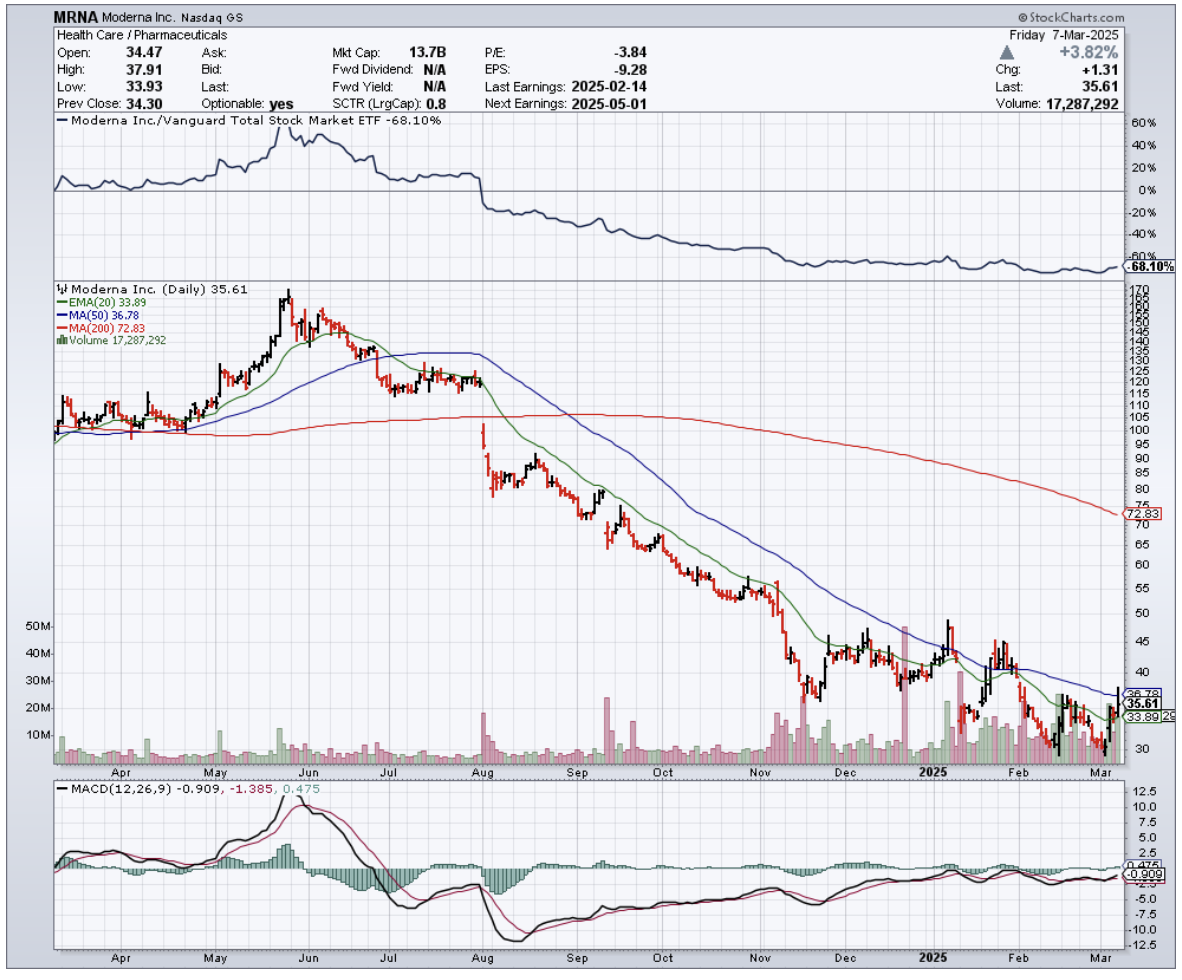
Mad Hedge Biotech and Healthcare Letter
January 23, 2025
Fiat Lux
Featured Trade:
(THE HARD TRUTH ABOUT THIS BIOTECH'S PIPELINE THAT WALL STREET DOESN'T GET)
(MRK), (AMGN), (AAPL)
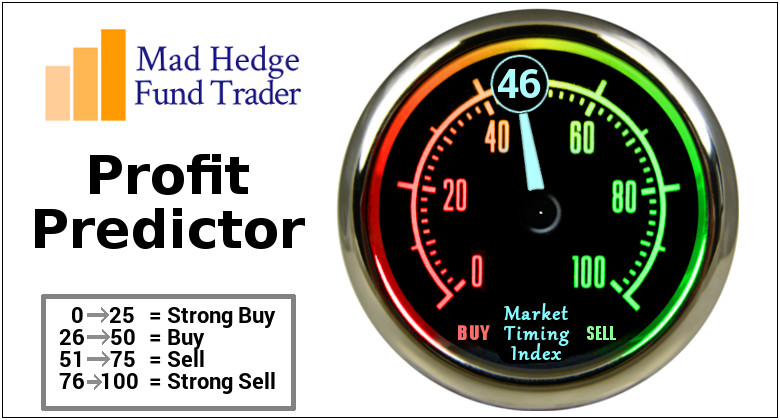
Earlier this month, while reviewing my biotech holdings during a layover at Chicago O'Hare, I got an interesting call from a long-time reader.
He was panicking about Merck (MRK) after seeing it trading near its 52-week lows, convinced the pharmaceutical giant was headed for trouble.
"Have you seen what Medicare negotiations did to Januvia?" he asked, referencing the 79% price reduction. "And Keytruda's patent expires in 2028!"
Here's the hard truth about this biotech's pipeline that Wall Street doesn't get: while everyone's fixated on Keytruda's patent cliff, Merck has quietly tripled their late-stage pipeline in just over three years.
We're talking more than 20 unique assets in late-stage development, plus another 50 in early stages.
The last time I saw this kind of pipeline expansion was during the early days of Amgen (AMGN), which turned out pretty well for investors who saw past the obvious.
Actually, Merck's current "crisis" also reminds me of the time I bought Apple (AAPL) right after Steve Jobs announced the iPhone. Everyone worried about the risk, while I saw the opportunity.
Merck just posted Q3 2024 numbers that would make most CEOs envious: revenue up 7% year-over-year to $16.7 billion.
Keytruda, their cancer blockbuster, grew 21% to $7.4 billion. Even their Animal Health division jumped 11%. These aren't the numbers of a company in trouble.
Speaking of investors, they've enjoyed a 126% total return over the past decade with Merck, despite more ups and downs than my last flight through turbulence.
The company's 5-year average Return on Equity sits at 25% (recently climbing to 28%), with Return on Invested Capital steady at 20%.
With a Weighted Average Cost of Capital around 8%, there's plenty of room for growth.
Yesterday, I was discussing these numbers with a former FDA commissioner (who shall remain nameless) over coffee.
He pointed out something fascinating: Merck's R&D spending is increasing alongside revenue growth. That's like a tech company doubling down on product development – exactly what you want to see in pharma.
For dividend hunters (and I know many of you are), Merck offers a 3.3% yield with a 7% five-year dividend growth rate.
The payout looks sustainable too, consuming 68% of earnings and 55% of free cash flow. It's not going to make you quit your day job, but it's better than the 1.4% you'll get from the S&P 500.
Looking at valuation, Merck trades at a P/E of 20.5, below its historical average of 22.3.
My own growth projections suggest a 13% annual rate going forward. Optimistic? Perhaps. But with their robust pipeline and near-term analyst projections, I've seen crazier things work out.
The company just announced a $15 billion share repurchase program, including plans to spend $7.5 billion over the next 12 months. When management puts that kind of money where their mouth is, I tend to pay attention.
Yes, Keytruda's patent cliff in 2028 is real. But so is Merck's late-stage pipeline of antibody-drug conjugates (ADCs) – think smart missiles in the war against cancer.
And unlike some biotechs, Merck has the financial muscle to weather any storm, with decreasing net debt and a solid cash position.
Remember what I always say about buying straw hats in winter? Merck right now is like finding a premium pharma stock in the discount bin.
Just like my friend who panicked and sold everything after the November 8 election (and missed the subsequent rally), sometimes the best opportunities come disguised as problems.
As for me, I'm looking at Merck as a potential long-term hold. The company's fundamentals remind me of other great turnaround stories I've traded successfully over the years.
With the healthcare sector currently out of favor and Merck trading near its 52-week lows, this might be one of those moments we look back on and wish we'd bought more.
And speaking of patents, maybe I should patent my strategy: “Buy great companies when everyone else is afraid.” Though I suspect Warren Buffett already beat me to that one.
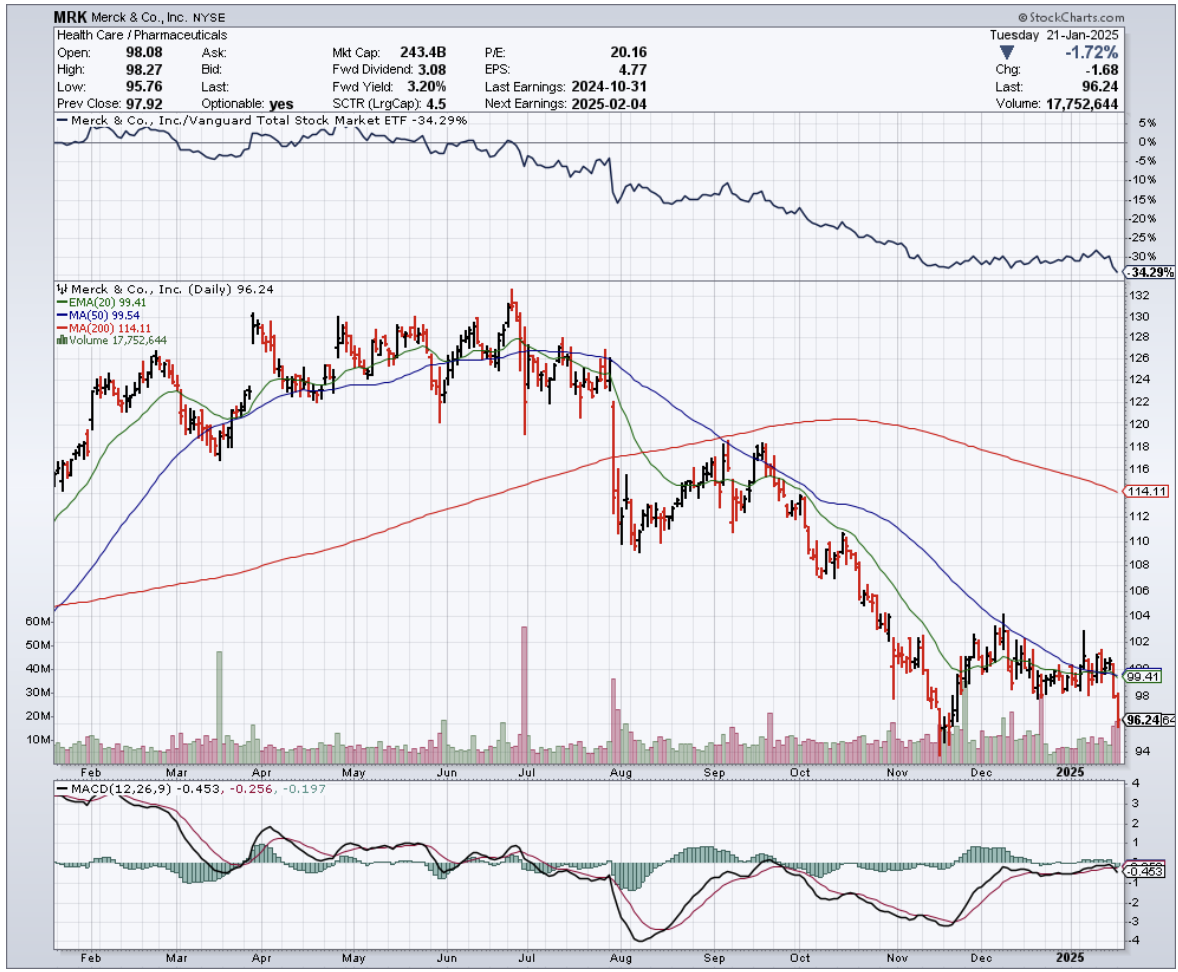
Mad Hedge Biotech and Healthcare Letter
December 31, 2024
Fiat Lux
Featured Trade:
(SOMETIMES WALL STREET GETS IT WRONG)
(BMY), (AAPL), (MRK)

Sitting in my stateroom aboard the Coral Princess, about 200 miles off Mexico's west coast, I found myself chuckling at the market's reaction to Bristol-Myers Squibb’s (BMY) latest developments. Sometimes Wall Street reminds me of my old physics professor - brilliant but occasionally missing the forest for the quantum trees.
Here's what caught my attention: BMY's stock has outperformed the broader market by +15% since July, yet still trades at a measly 7.91x forward P/E while its sector peers strut around at 20.53x. It's like finding a Ferrari in a used car lot, priced like a Corolla.
The cynics, of course, point to the patent cliff. "What about Eliquis in 2026? Opdivo in 2028?" they ask, wringing their hands. But that's exactly where it gets interesting.
Just earlier this month, BMY announced FDA approval for Opdivo Qvantig - their new subcutaneous version that cuts treatment time from 30 minutes to 5 minutes. If you've ever spent time in cancer treatment centers like I have, you know those 25 minutes make a world of difference.
BMY's commercial team expects this version to capture 75% of Opdivo's business, with 30-40% of patients switching from IV. That's not just convenience - it's strategic patent life extension.
Speaking of strategy, let's talk about their growth portfolio, which has quietly expanded 20% year-over-year and now represents 48.7% of their business.
Remember when Apple (AAPL) transformed from computers to mobile devices? BMY is pulling a similar pivot, just without the flashy keynotes.
Take their $14 billion Karuna acquisition. Their newly approved schizophrenia treatment, Cobenfy, targets a market projected to hit $15.23 billion by 2034. The timing here is masterful - monetization starts in early 2025, well before the patent cliffs hit.
Meanwhile, they're cleaning up their balance sheet faster than a neat freak with a new vacuum. They've already slashed $4.31 billion in debt this year, with plans to cut $10 billion by 2026.
Their free cash flow has grown to $13.8B, up 18.1% sequentially. At this rate, they'll have plenty of dry powder for more strategic moves.
But here's what really makes me scratch my head: while everyone's fixated on the patent cliff, BMY has quietly added 8 new oncology registrational trials in the past year. Their oncology trio - Opdivo, Yervoy, and Opdualag - is growing at 7.6% year-over-year.
Sure, Merck's (MRK) Keytruda is the 800-pound gorilla with $25 billion in sales, but BMY's playing a different game - diversification with shots on goal across multiple therapeutic areas.
Now, I'm not suggesting you back up the truck tomorrow morning. The stock might see some pressure after the January 3, 2025 ex-dividend date, possibly testing support at $51 or even $48. But with a 4.45% dividend yield and a valuation at half its historical average, patient investors might find this an interesting entry point.
Speaking of timing - Wall Street's greatest fortunes were made by investors who saw value where others saw problems. Right now, most analysts are staring at BMY's patent cliff like deer in headlights.
Meanwhile, I'm seeing a company with a 4.45% dividend yield, a growth portfolio expanding at 20% annually, and a valuation that's practically begging to double.
As I wrap this up from somewhere off the Mexican coast (where I'm supposedly on vacation but can't help analyzing stocks between rounds of Monopoly), I'm reminded of something I learned in my decades of trading: The crowd is usually looking through the wrong end of the telescope.
While they're zoomed in on 2026's patent expirations, they're missing the transformation happening right now in front of their eyes.
Maybe that's why I've averaged +50% returns for over a decade - I tend to look where others don't. BMY just might be one of those opportunities that makes next year's Christmas gift to my subscribers an even bigger winner than this year's +75.25% return.
Now, if you'll excuse me, my banjo needs tuning, and I have a Monopoly empire to build. But remember - in both board games and markets, the best players are always thinking three moves ahead. BMY's management certainly is.
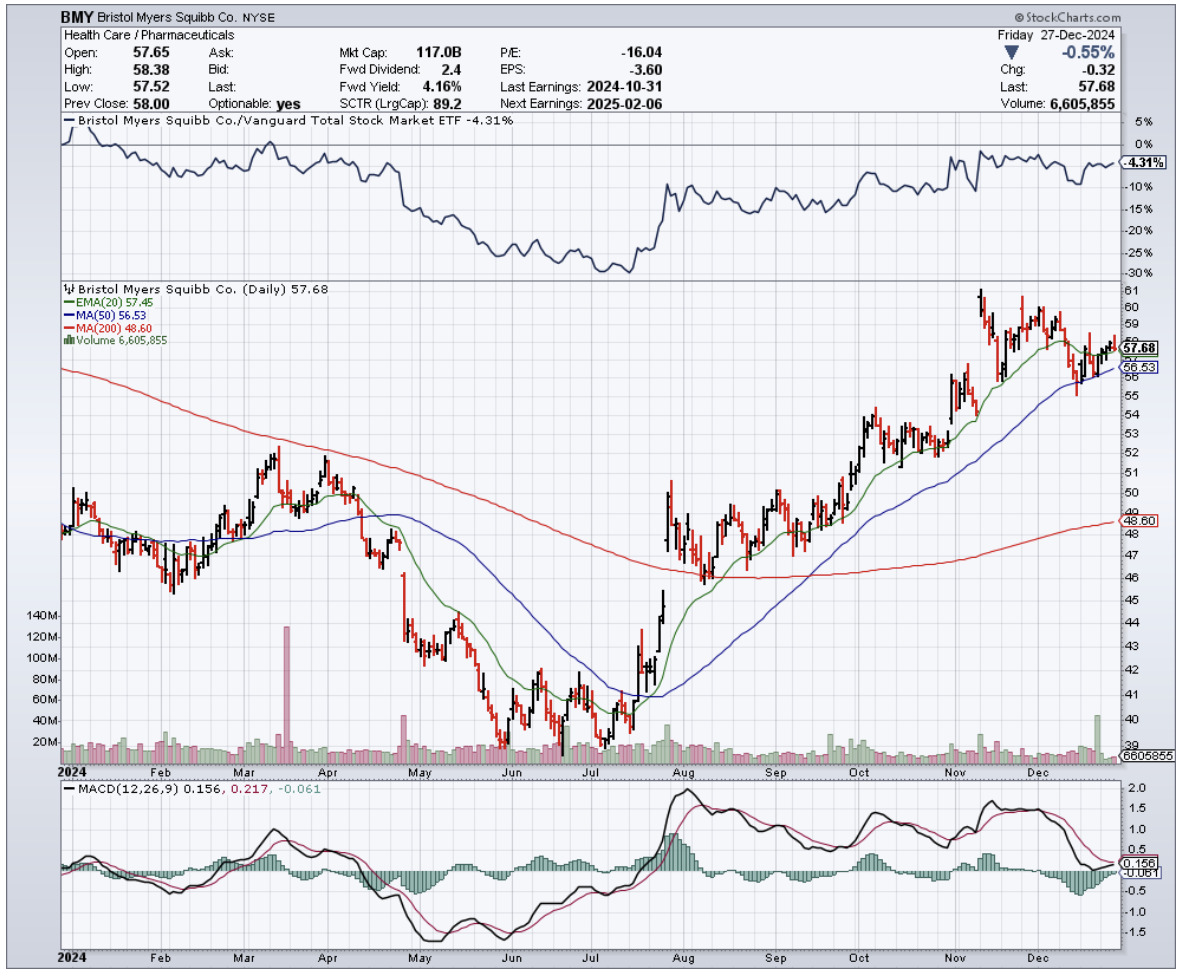
Legal Disclaimer
There is a very high degree of risk involved in trading. Past results are not indicative of future returns. MadHedgeFundTrader.com and all individuals affiliated with this site assume no responsibilities for your trading and investment results. The indicators, strategies, columns, articles and all other features are for educational purposes only and should not be construed as investment advice. Information for futures trading observations are obtained from sources believed to be reliable, but we do not warrant its completeness or accuracy, or warrant any results from the use of the information. Your use of the trading observations is entirely at your own risk and it is your sole responsibility to evaluate the accuracy, completeness and usefulness of the information. You must assess the risk of any trade with your broker and make your own independent decisions regarding any securities mentioned herein. Affiliates of MadHedgeFundTrader.com may have a position or effect transactions in the securities described herein (or options thereon) and/or otherwise employ trading strategies that may be consistent or inconsistent with the provided strategies.
This site uses cookies. By continuing to browse the site, you are agreeing to our use of cookies.
OKLearn moreWe may request cookies to be set on your device. We use cookies to let us know when you visit our websites, how you interact with us, to enrich your user experience, and to customize your relationship with our website.
Click on the different category headings to find out more. You can also change some of your preferences. Note that blocking some types of cookies may impact your experience on our websites and the services we are able to offer.
These cookies are strictly necessary to provide you with services available through our website and to use some of its features.
Because these cookies are strictly necessary to deliver the website, refuseing them will have impact how our site functions. You always can block or delete cookies by changing your browser settings and force blocking all cookies on this website. But this will always prompt you to accept/refuse cookies when revisiting our site.
We fully respect if you want to refuse cookies but to avoid asking you again and again kindly allow us to store a cookie for that. You are free to opt out any time or opt in for other cookies to get a better experience. If you refuse cookies we will remove all set cookies in our domain.
We provide you with a list of stored cookies on your computer in our domain so you can check what we stored. Due to security reasons we are not able to show or modify cookies from other domains. You can check these in your browser security settings.
These cookies collect information that is used either in aggregate form to help us understand how our website is being used or how effective our marketing campaigns are, or to help us customize our website and application for you in order to enhance your experience.
If you do not want that we track your visist to our site you can disable tracking in your browser here:
We also use different external services like Google Webfonts, Google Maps, and external Video providers. Since these providers may collect personal data like your IP address we allow you to block them here. Please be aware that this might heavily reduce the functionality and appearance of our site. Changes will take effect once you reload the page.
Google Webfont Settings:
Google Map Settings:
Vimeo and Youtube video embeds:
